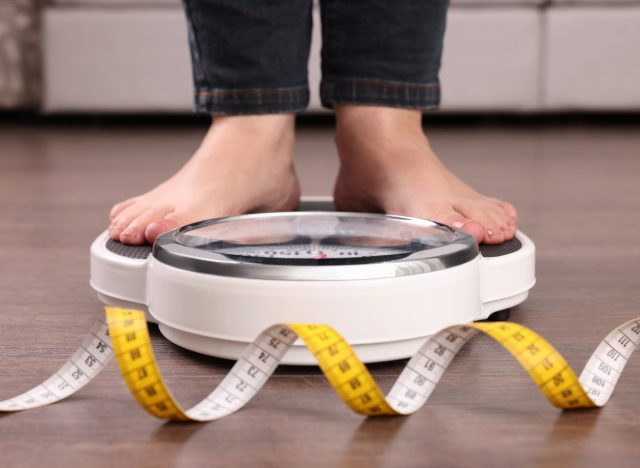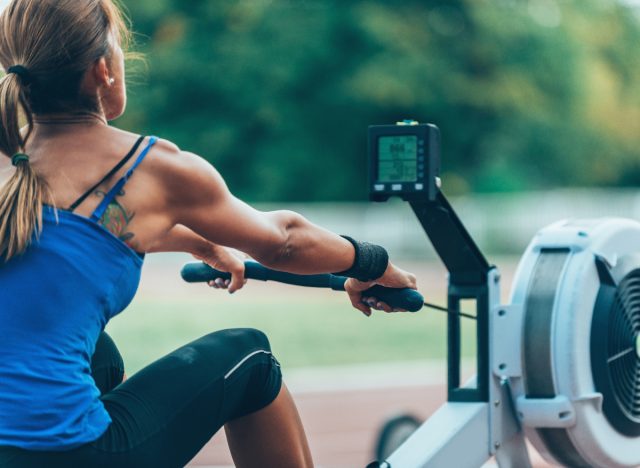The Best Workout To Manage Low Blood Sugar, Experts Say

If you deal with low or high blood sugar, then you know just how important it is to keep your levels in check. Working out is an excellent way to manage low blood sugar, and we have a great exercise routine for you. We reached out to Dr. Mike Bohl, the Director of Medical Content & Education at Ro and a certified personal trainer, to understand just what happens to your body when your blood sugar isn't well managed and how exercise can be your best friend.
In short, it's so important to work out, eat just the right foods, and maintain a healthy body weight. People who deal with pre-diabetes or type 2 diabetes have what's called insulin resistance. This means their cells are not as responsive to insulin as they should be, making what should be the normal process of transporting glucose into your cells from your blood challenging, causing heightened blood sugar levels.
By working out, you lower your body's blood sugar levels for a short period of time, because your body fuels up on blood sugar when exercising. Read on to learn more about the absolute best workout to perform to manage low blood sugar. And next up, don't miss The 6 Best Exercises for Strong and Toned Arms in 2022, Trainer Says.
Exercise works wonders

According to Dr. Bohl, "Normally, there is sugar circulating in the bloodstream as glucose. When you start working out, your muscle cells need more energy, so glucose is transported from the bloodstream into the cells where it can be metabolized and turned into energy. This, in turn, lowers the amount of glucose left in the blood." He continues, "A hormone known as insulin is responsible for transporting glucose into cells, so the more you work out, the more sensitive your body becomes to the effects of insulin. And this is the other way working out helps maintain good blood sugar levels. People who have uncontrolled blood sugar levels, like those with prediabetes or diabetes, have an issue with the hormone insulin."
Related: The #1 Outdoor Workout To Lose Belly Fat in a Week, Says Trainer
If you don't work out, you're putting your health at serious risk

Working out is a great plan to maintain good blood sugar levels, as it addresses insulin resistance and improves the movement of glucose into cells from your blood, Dr. Bohl explains. If you don't work out, you risk becoming overweight or even obese, which are major risks for diseases like type 2 diabetes.
"With type 2 diabetes, if blood sugar levels are not well controlled by lifestyle modifications and/or medications, they can get very high, which is unhealthy for the body for a number of reasons," Dr. Bohl says, adding, "Chronically elevated blood sugar levels can damage the eyes, kidneys, blood vessels, and more. And extremely high blood sugar levels can become a medical emergency, leading to coma and even death."
Related: The Worst Exercise Habits That Are Aging You Faster, Trainer Says
Aerobic exercise and resistance training are key

There are two very effective types of exercise to perform at the gym to deal with high blood sugar, according to Dr. Bohl. They include aerobic exercise and resistance training. Both workouts will require your muscles to use glucose, which benefits insulin sensitivity. Both workouts will also burn calories. Obesity or being overweight puts you at risk factor for high blood sugar levels and insulin resistance, so getting your weight in check with a routine exercise program can help manage your blood sugar.
We chatted with Tim Liu, CSCS, an online fitness and nutrition coach, who also stresses the importance of exercise to manage low blood sugar. According to Liu, "It helps lower the insulin response and glucose spike from eating a meal that may be high in carbs." He suggests, "For lower impact, a brisk walk or low-intensity cardio. Interval/conditioning workouts can also help with glucose metabolism."
Know your body

Dr. Bohl cautions if you feel your blood sugar is low during a workout, it's important to replenish your body's blood sugar levels very quickly. You can do this by eating some carbohydrates pre- and post-workout. He suggests, "If you're experiencing low blood sugar during the workout, it's an opportunity to take a break and have another carb snack—either in the form of food, a sports drink, or a glucose gel."
If you are at risk of low or high blood sugar, it's imperative to know the symptoms each present. Dr. Bohl suggests, "Monitor how their body responds to certain types of physical activity. Starting, stopping, or changing an exercise routine may impact how the body processes blood sugar and may require someone to change how they use their blood-sugar-lowering medications. Keeping an easy snack on hand is always a good idea for people at risk of low blood sugar, and regularly monitoring blood sugar is a good way to make sure it isn't getting too high."








